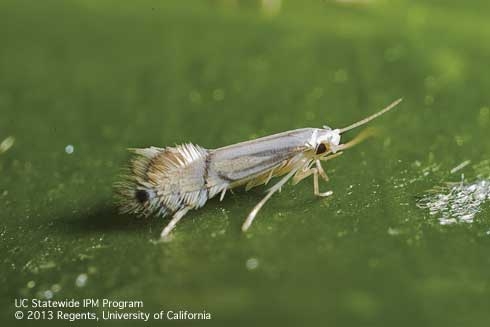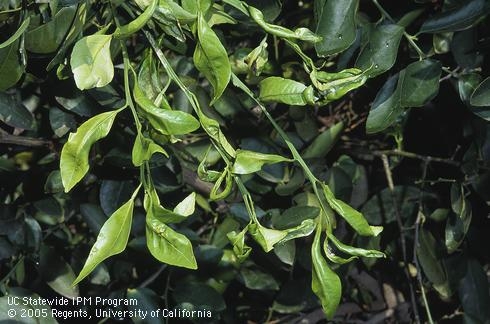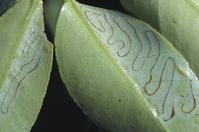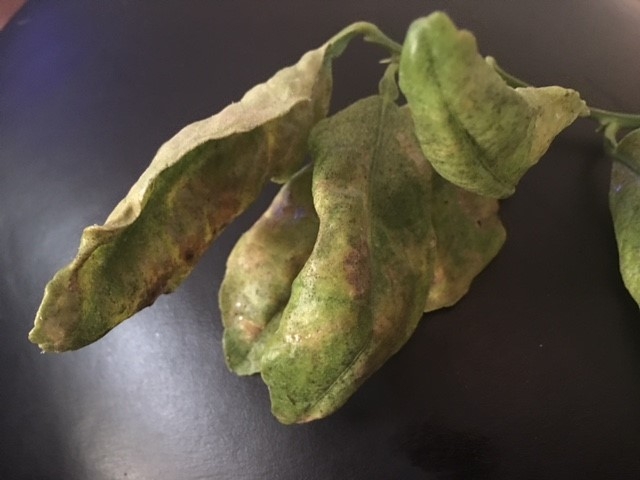
Posts Tagged: lepidoptera
The Leafminers are Here
Leafminer, sometimes Leaf Miner. It's that time of year. Those little moths come out in the late afternoon and flit about. They lay their eggs and when they hatch the larvae start burrowing through the leaf. The recent heat and also the generally warm summer have set them off. And it is obvious now. The heat has exacerbated the collapse and drying of the leaves and on older trees it looks like trees have been decorated with a sprinkling of light brownish ornaments. It is disturbing. But it's not the end of the world, like …………ACP can be.
Leafminer adults are tiny moths less than 0.12 in long (2 mm) with wings span twice as wide.
Pretty shocking from a distance
Citrus leafminer larvae feed by creating shallow tunnels, referred to as mines, in young leaves. It is most commonly found on citrus (oranges, mandarins, lemons, limes, grapefruit and other varieties) and closely related trees (kumquat and calamondin). The larvae mine the lower or upper surface of the leaves causing them to curl and look distorted. Mature citrus trees (more than 4 years old) generally tolerate leaf damage without any effect on tree growth or fruit yield. Citrus leafminer is likely to cause damage in nurseries and new plantings because the growth of young trees is retarded by leafminer infestations. However, even when infestations of citrus leafminer are heavy on young trees, trees are unlikely to die. But they can sure struggle pushing new leaves that then get attacked anew.
Several years ago, we did a trial where we sprayed mature trees with leafminers every month for 18 months with a rotation of different chemicals and even the most heavily treated trees had some damage on them. The most heavily infested trees looked horrible, but in that period of time there were no lemon yield differences. Young trees treated with a systemic were able to free themselves of infestation. This has been commented on by others, that soil applied systemics on heavier soils can have problems controlling leafminers.
http://ipm.ucanr.edu/PMG/r107303211.html
Photos: Tunnels and the rapidly dried leaf after a heat spell
The Leafminer are Coming
Calls are coming in about leafminer. It's there on the new growth, twisting and distorting it. In fact, it' been there most of the year. It was working new growth all winter long, because it was a warm winter. Right now, though, they are more active and more damage is being seen. So the question is what do you spray?...................................Nothing. Studies have been done that show little or no yield is affected by the infestation. It looks horrible and calls you to do something, but there's little that can be done. A trial we did 10 years ago involved almost weekly sprays of rotational materials on mature trees and it was impossible to keep the damage down. It happened. On young trees there are some possibilities, but even in this case it is tough.
Citrus leafminer larvae feed by creating shallow tunnels, referred to as mines, in young leaves. It is most commonly found on citrus (oranges, mandarins, lemons, limes, grapefruit and other varieties) and closely related plants (kumquat and calamondin). The larvae mine the lower or upper surface of the leaves causing them to curl and look distorted. Mature citrus trees (more than 4 years old) generally tolerate leaf damage without any effect on tree growth or fruit yield. Citrus leafminer is likely to cause damage in nurseries and new plantings because the growth of young trees is retarded by leafminer infestations. However, even when infestations of citrus leafminer are heavy on young trees, trees are unlikely to die.

leafminer damage




